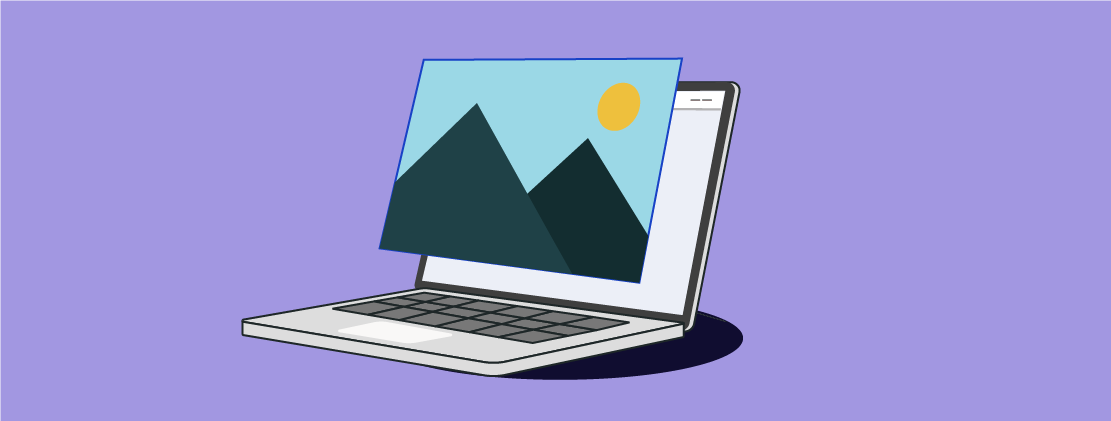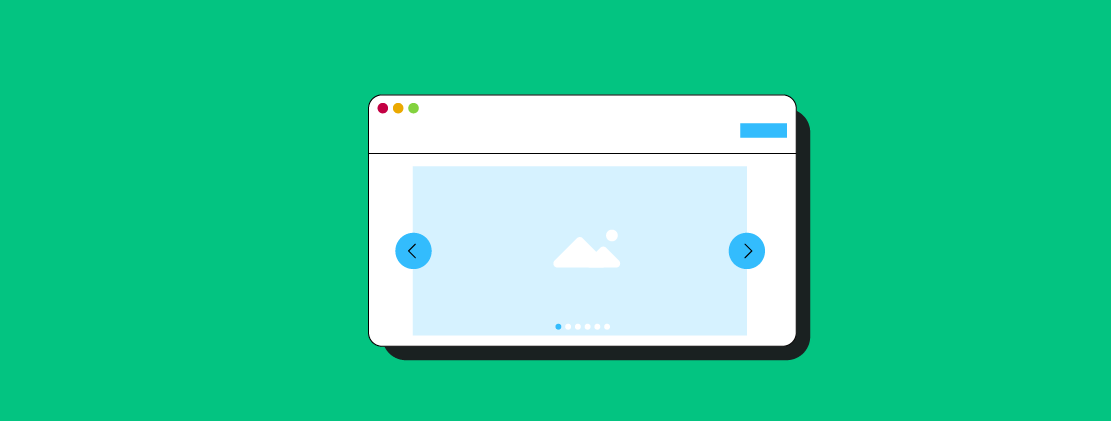A splash page is a standalone web page that emerges before users enter a company’s site. This page can include graphics, animations, or brief information to grab attention and set the site's tone. A splash page isn’t the final destination of users as it does not contain the primary content.
In this article, we’ll unveil why you should use a splash page and how it differs from a landing page. We’ll also show you how to create an effective splash page and provide some helpful tips and examples.
Why should you use a splash page?
A splash page can help business owners attain their primary business goals in various ways. Below, you can find a list of reasons that might make you consider using a splash page for your company:
- Promotion and marketing. Marketers can promote special events, deals, and discounts with splash pages. Adding information about exclusive deals to splash pages allows you to establish interaction, encourage engagement, and improve visibility.
- Event promotion. If your business is involved in events, product launches, and conferences, a splash page will help you provide participants with details about upcoming events, launches, webinars, etc.
- Attention-grabbing introduction. A catchy message, exclusive deal, or exciting event featured on your splash page can be a great introduction to your company’s site. It will help you stay top of mind and establish interaction.
- Collecting email subscribers. Splash pages enable you to effectively gather email addresses of potential customers. They always include clear and visible call-to-action buttons encouraging subscribing and receiving updates regularly. As a result, you’ll have a long mailing list and an additional channel for nurturing your prospects.
- Announcements and updates. You can incorporate a splash page for announcing important events or providing subscribers with updates on your product or service. It can cover various scenarios, such as changes to your website, product launches, and any other information you feel is necessary when users discover your brand.
Now that you have some reasons to incorporate a splash page into your marketing efforts, it’s time to find out the difference between a splash and a landing page.
Splash Page vs Landing Page
Splash and landing pages aren’t the same because they serve different business purposes. In this section, we’ll compare the two in detail to identify the main dissimilarities.
A splash page is a standalone page that serves as an introduction to a website and usually includes a single message, visual, or animation. This page often has a skip option since not all users like its visual impact. The content featured on a splash page is minimal, including images and straight-to-the-point messages rather than detailed information. Since splash pages have attention-grabbing elements, business owners utilize them for announcements, promotions, and events.
A landing page is aimed at gaining conversions. These might include efforts related to lead capturing, product promotion, or other desired actions. A landing page contains detailed information about a specific product, service, or offer, applying testimonials, benefits, and visible CTAs encouraging conversions. It can educate potential customers and lead them toward a specific action that brings prospects toward purchase. You can encounter brands using landing pages for paid advertising, social media promotions, and email marketing because they help. With SendPulse, you can build compelling landing pages within minutes without knowledge of the code using pre-built templates.
Now that you clearly understand the main difference between the two terms, let’s proceed to the next section to explore how you can develop an effective splash page.
How to create an effective splash page?
Building an effective splash page requires your team to map everything out, identify your key goals, analyze the target audience, and ensure a seamless user experience. Below are the steps you should take to create a powerful splash page that brings you towards achieving your main objectives.
- Identify your key goals. Every splash page should have a main purpose, so think about this before creating one for your company. It can be a tool for promoting your new event, showcasing product launches, or collecting prospects’ email addresses. Regardless of the main objectives, identifying them will help you make well-informed decisions on splash page design, elements, message, and other aspects.
- Understand your target audience. To create a splash page that resonates with your potential clients, you need to know the preferences and interests of your target audience. Consider conducting short research that will help you find a relevant message and visuals and encourage prospects to complete the desired action.
- Keep your page simple. Make sure that your splash page features only the most important information in brief. Your content should be concise, focusing on the main message and call to action button. It will help you avoid overwhelming leads with unnecessary information.
- Add compelling visuals. Images or graphics included in your splash page should be high quality and attention-grabbing. Since visuals are the first thing users see, you should ensure that they look good on the page, enticing prospects to convert.
- Create a brief message. Your message should communicate the main purpose of your splash page. That’s why you need to create a compelling headline and copy supported by visually appealing images. It will prevent you from overwhelming your prospects and encourage the desired action.
- Add prominent CTAs. Every splash page has a business purpose, so it should include a clear and visible call to action button. Splash pages vary and allow you to encourage site visitors to subscribe for updates, enter your company site, or receive special offers.
- Ensure responsive design. Since many potential customers use their smartphones to explore information on the web, it’s essential to ensure the mobile-first design of your splash page. You need to create pages that look good on any device and provide a seamless user experience.
- Check for fast loading time. Consider optimizing your splash page loading time because it can become the reason for potential clients to leave. You should use compressed images and minimize scripts to ensure users don’t have to wait to explore your message.
- Conduct A/B testing. Try multiple splash page versions that suit your main purpose and target audience’s needs. Consider implementing A/B testing to find the perfect combination of visuals, messaging, and CTAs. By trying several options, you’ll be able to identify elements that work best with your audience.
Now that you have a step-by-step guide on creating an effective splash page, let’s explore some tips to grab attention and encourage site visitors to action.
8 Splash Page Tips
In this section, you’ll find a list of tips that will help you develop a clear and attention-grabbing slash page. So let’s dive in.
- Keep it action-oriented. To reach the primary goals of your splash page, you need to make it action-orientated. Consider including all the elements necessary for users to complete the desired action. It can be a visible CTA, concise message, and visuals that entice site visitors to subscribe to your email newsletter, search for items, or purchase with a discount code.
- Use a countdown timer. Countdown timers are perfect for limited-time promotions, sales, and exclusive offers. They establish a sense of urgency and encourage users to take action as soon as possible. The fear of missing out helps you reach the business goals you want to achieve through your splash page faster.
- Be consistent. The elements and language of your splash page should align with your overall brand tone and messaging style. You need to be consistent across all your channels to establish recognition. In addition to language and messaging, your visuals, color scheme, and fonts should also comply with your branding guidelines.
- Entice subscribers with special offers. Exclusive deals, discounts, and offers allow you to attract prospects’ attention and encourage them to complete the desired action. It will help you increase your customer base and improve conversions.
- Add a skip option. Your splash page should allow site visitors to skip this standalone page and proceed to the primary content of your website. It will help you improve user experience and ensure that site visitors get the necessary information immediately and complete the actions they strive for.
- Add a clear CTA. Since every splash page has a specific goal, you should ensure users can help you reach it. They complete the necessary actions by clicking the call to action button. That’s why you need to create a splash page that has a clear, visible, and concise CTA. It will enable your potential customers to proceed to your offers, events, language and country settings, and other aspects that help you attain your business objectives.
- Utilize analytics. If you want to have a clear understanding of your splash page performance, it’s crucial to apply analytics tools. They will help you uncover whether your splash page resonates with your target audience and brings valuable results. After receiving insights into your splash page, you can craft it based on customer preferences, interests, and overall activity on your site.
- Add a concise message. Your message should be brief to communicate the main idea behind your splash page. With a short and sweet message, you’ll be able to grab attention and encourage users to explore your content further. Support your message with visuals to interest site visitors and make them discover more information about your brand.
Now that you know the best practices, let’s discover some excellent splash page examples. They will inspire you to create a splash page that encourages action.
Splash Page Examples
You can find numerous examples of splash pages widely used by brands. In this section, we’ll provide some successful examples to inspire you.
Fighting Pretty
Fighting Pretty, an NGO established to support women during their cancer treatments, incorporates a splash page to encourage new users to join the community. This non-governmental organization shows new site visitors a short and to-the-point message, participants’ image, and a visible and clear call to action button. This splash page matches the organization’s color scheme, fonts, and style, aligning it with the primary website.

Zara
Zara, the famous clothing brand, is an excellent example of the right usage of splash pages. When you proceed to the company’s website, you’ll instantly see a page full of visually appealing visuals and the opportunity to choose country and language preferences. This splash page aims to ensure the best user experience for site visitors, allowing them to explore items in their language, currency, and delivery options.
CB Creative Blog
When users open the CB Creative Blog website, the first thing they see is a splash page. The company offers potential subscribers to explore daily design news, reviews, and how-tos once they sign up for its email newsletter. The main purpose of this splash page is to increase the number of contacts on the mailing list. The page’s message is short and clear. After reading the main message, site visitors can share their emails and take the desired action by clicking on a call to action button.

Congrats, now you know what a splash page is and why it’s useful for your company. Hope that our guide, tips, and examples will help you create an effective splash page that grabs attention and allows you to reach the desired goals.
References:
- This article defines the term and provides some useful tips for creating an effective splash page.
- In this article, you’ll find some excellent examples of splash pages.
Learn more about creating a converting splash page on our blog!
Last Updated: 28.09.2024




or